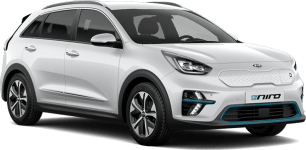The space in the EV6 rivals much larger SUVs and tall families will rejoice with how much leg- and headroom you get in both rows.
The comfort for passengers is pretty good, with comfortable seats in both rows that feel well-cushioned. The floor in the rear is flat, which accommodates any middle-seaters.
Being the base grade, you don’t get electric front seats, which is a bit rough for its price point but the driver’s side does get powered lumbar support, which I appreciate on longer journeys.
Individual storage is fantastic for the class and the front gets two cupholders, a drink bottle holder in each door and glovebox and middle console. There are multiple storage nooks and a utility tray on the topside of the floating centre console (sized for items like keys, wallet, phone etc).
The large shelf underneath the centre console easily accommodates a handbag and snacks for any kids in the back (or adults, no judgement).
Individual storage in the back is as good as the front, with plenty of spots to tuck away all of the paraphernalia that kids seem to attract. There are also two cupholders in a fold-down armrest, a drink bottle holder in each door and map pockets.
On the whole, my seven-year-old really enjoys being in the back seat because of the amenities and space he has. He finds the EV6 to be an easy car to get out of but we all struggle with the flush door handles! They can be terribly annoying to use as they don’t pop out on approach or when you unlock the doors. If you have your hands full and have little T-Rex hands like me, it can be awkward to open.
What isn't awkward to use is the technology! The 12.3-inch touchscreen multimedia system is quick to respond and the system itself is easy to navigate once you spend some time with it.
The 12.3-inch digital instrument cluster is semi-customisable but not as pretty in its graphics as it could be. It has two styles to choose from - white or black, and the white is a little too sterile for my liking.
The multimedia system features wired Apple CarPlay, Android Auto and built-in satellite navigation with map updates for 10 years.
Charging options are solid with a single USB-A and and two USB-C ports up front, a wireless charging pad and a two 12-volt ports to choose from. The rear enjoy a three-pin standard house port and two USB-C ports as well.
The back seat has a 60/40 split and it's handy that you can lower them from the boot with manual levers. The boot itself is a good size with 490L when all seats are in use but you miss out on a powered tailgate in this model.
The frunk storage also offers an additional 52L, which is perfect to keep any charging cables or the tyre mobility kit stored away.










.png)

































.png)































